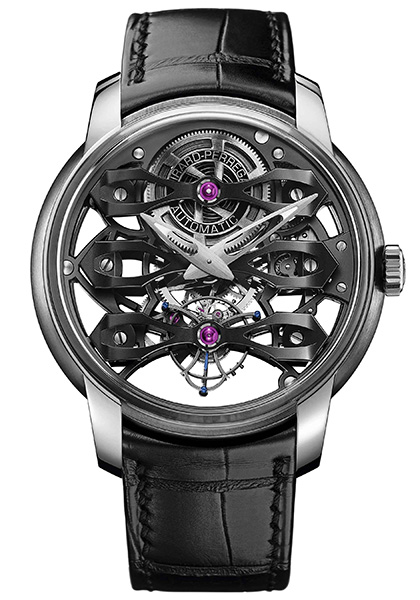These days, horological eroticism is largely the province of Ulysse Nardin with its engraved dials featuring nude figures. But Girard-Perregaux is also stripping off. The watchmaker has delicately undressed one of its most successful models, the Neo-Tourbillon with Three Bridges, in three stages.

This is the contemporary version of the Tourbillon with Three Gold Bridges. It’s an haute horlogerie piece whose main architectural feature is both the technical point of departure for the movement, and the raison d’être of the watch. By placing the three main bridges that the movement needs (barrel, gear and tourbillon) on the dial side, by orienting them in parallel lines across the case, and removing the dial, Girard-Perregaux foreshadowed those ultra-technical, ultra-visible, ultra-geometrical movements we have become used to seeing today.

The Neo-Tourbillon with Three Bridges updates this idea, taking its main ingredients but employing a completely different aesthetic vocabulary. The bridges are no longer flat strips (with or without arrow-shaped tips); here, they are arcs. They arch gracefully over the top of the movement, creating a deep valley underneath. The bridges in question are made of openworked blackened titanium. The case is also in titanium, and the movement is dark grey and black. The structure and the spirit remain, but everything else has changed.

And then, the Neo-Tourbillon did away with the bottom. All the superfluous material was shed, like a pair of trousers, or a skirt, perhaps, and the Neo-Tourbillon Skeleton was launched. The main plate was cut away. Metal was removed from beneath the bridges, under the tourbillon and the wheels, making it possible to see right through the movement, and further accentuating the impression of depth. The move also confirmed the visionary foresight of the Three Gold Bridges concept, which carried within it the seeds of skeletonisation. Up to this point, there was a logical progression, an inevitable evolution even, in that a skeletonised version is one of the many tools watchmakers use to bring watches to life.

Then, in 2019, the Quasar took its top off. In place of a satin-brushed titanium case, it has a caseband entirely carved from sapphire. This transparent, hard, noble, technical material reveals the entire calibre from every angle. It’s even possible to see the bands that hold it together, which were hitherto concealed in the metal. All that’s left is a minute undergarment, which Girard-Perregaux could very well dispense with altogether, leaving the watch in its birthday suit.

In 2010, Girard-Perregaux displayed its innovative credentials once again, with the Laureato Evo Tourbillon Sapphire. Its three bridges were carved from wafers of sapphire. If this concept were combined with the Quasar, we’d be looking at a totally unique object. It could be called the Triple Sapphire Quasar, the White Star, the... SuperNova? To do the job properly, and to illustrate the huge strides that have been made in sapphire technology, the bridges would be skeletonised and, of course, all in a line. The strip-tease would be complete, and the watch would certainly cause a frisson.







